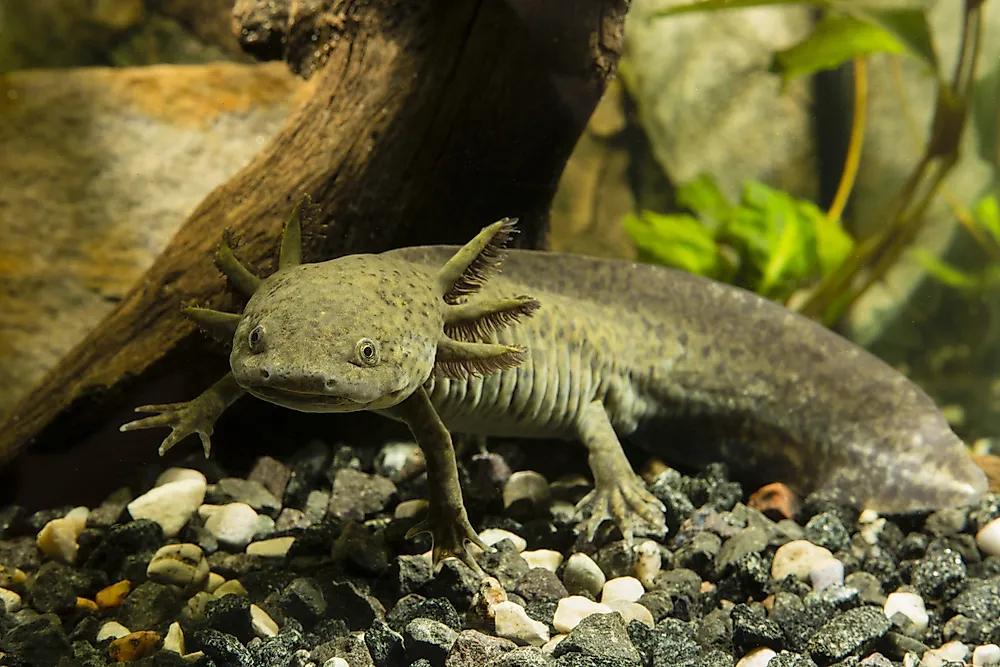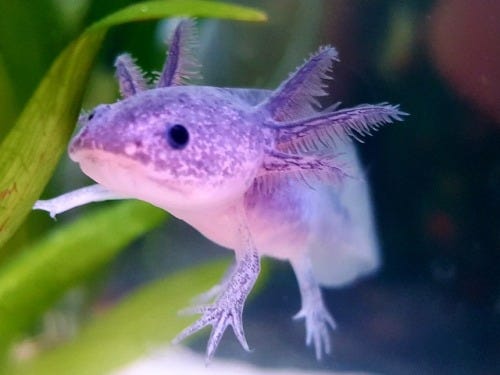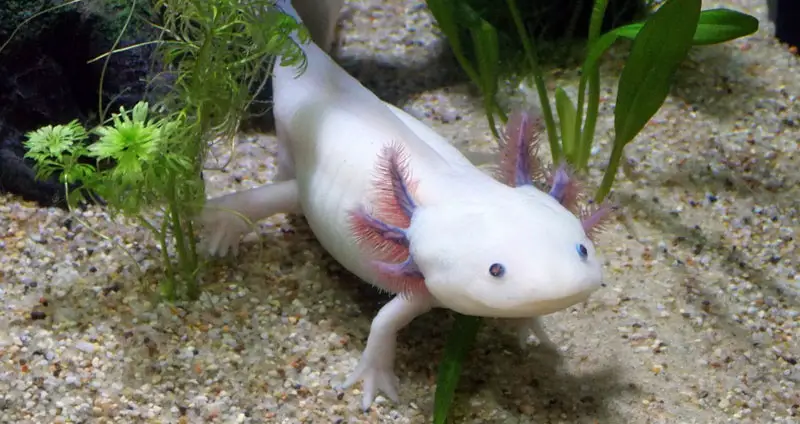What Are Axolotl Morphs:
Axolotls are amphibians from Mexico. They are also known as Mexican salamanders. The axolotl has been used for centuries in medicine, and they are still used today. Their scientific name is Ambystoma mexicanum. Axolotls are amphibians that look like salamanders.
They live in fresh water and eat algae. The name “axolotl” comes from the Nahuatl language meaning “water monster.”
When they grow up, these animals look like regular salamanders, but when they mature, they change into something else entirely.
They become aquatic creatures with gills instead of lungs, and they lose their legs and tails. This transformation happens naturally, but scientists believe that it could be used for medical purposes.
1. Silver Dalmatian Axolotl Morphs
A silver dalmatian axolotl morph is an amphibious salamander with a black body and white spots on its back. It is native to Mexico but is also found in parts of Central America and South America.
These are not true dalmatians but rather axolotls (a type of salamander). They are also known as Mexican fire belly newts or Mexican spotted salamanders.
The axolotl is a small, semi-aquatic amphibian native to the Americas that has been used in research for over 100 years. It is one of only two species of salamanders that can regenerate limbs and other body parts after injury.
The axolotl is an important model organism for studying regeneration because it shares many similarities with humans. For example, both animals
2. Axolotl Green Axolotl Morph
This is a morph between two species of axolotls. The green axolotl is native to Mexico and Central America. The red axolotl is found throughout North America, Europe, Asia, Africa, Australia, New Zealand, South America, and the Caribbean.
Both species are popular aquarium pets because of their ability to change color. However, only the green axolotl can be bred in captivity.
The green axolotl has been used in scientific studies to help understand the development of human diseases. It was also used in the production of vaccines against tetanus and diphtheria.
3. Chimera Axolotl Morph
This is a morph between two different species of axolotls. The chimera axolotl is a hybrid between the common Mexican axolotl (Ambystoma mexicanum) and the Chinese giant salamander.
The result is a creature that looks like a cross between a fish and a salamander. This makes it very popular among aquarium enthusiasts because it’s rare and beautiful.
But this isn’t just any ordinary chimera axolotl. It’s a mutant strain called the Chimera Axolotl Morph.
The mutation was discovered when scientists at the University of California, Berkeley were studying the genetics of axolotls, which are amphibians native to Mexico. They found that some of these animals had mutations in genes that control growth and development.
These mutants are extremely rare, however, and only exist in captivity. So far, there haven’t been any reports of them being released into the wild.
4. Melanoid Axolotl
The Melanoid axolotl is a species of salamander native to Mexico and Central America. Its scientific name means “little frog” in Nahuatl, the language spoken by the Aztecs. They live in ponds, streams, ditches, and other slow-moving water bodies. Their skin color varies from light brown to blackish green depending on the season.
The axolotl is a Mexican salamander species that has been used for centuries in Mexico to treat skin diseases such as eczema. This animal contains a substance called melanin, which helps protect against UV rays.
5. Wild Axolotl
The wild axolotls are a species of salamander found in Mexico. They are also known as Mexican Giant Salamanders. These animals are native to the Pacific coast of Mexico from southern Baja California to Chiapas. Wild axolotl lives in streams and rivers where they feed on small invertebrates such as insects, worms, snails, and other aquatic creatures.
They grow up to 2 inches long and weigh about 1 ounce. They are also known as Mexican fire belly newts.
6. Golden Albino Axolotl
The golden albino axolotl is a species of salamander native to Mexico. They live in water bodies such as ponds, lakes, and streams. Their skin color varies from yellowish orange to bright gold.
This animal has been used for medical research since the 1970s. They are also known as Mexican walking fish, and they are one of the oldest living amphibians. Their skin color changes from yellowish green to orange when they mature.
Because axolotls are cold-blooded animals, they need to stay warm during the winter months. So they hide beneath rocks or logs in shallow pools. During the summer, they seek out sunny areas near fast-moving currents of water.
7. Copper Axolotl Morph
Copper axolotls are amphibians found only in Mexico. They’re called axolotls because they resemble salamanders, but they’re actually closer relatives to frogs than to salamanders.
They’re also known as Mexican walking fish, copperhead fish, and Mexican water dogs. The name “copperhead” comes from the fact that when they’re threatened, they turn bright red.
Axolotls live in freshwater streams and ponds throughout Central America and northern South America.
They spend most of their lives underwater, where they eat algae and small invertebrates. But every spring, they emerge from the water to mate and lay eggs. Then they return to the stream or pond until the next breeding season.
When they mature, axolotls grow to be about 1 foot long (30 cm) and weigh between 2 and 4 pounds (1 kg). Copper axolotl’s skin is translucent and covered with tiny bumps, making them appear shiny.
Their eyes are large and round, and they have two pairs of nostrils at the top of their head. Their bodies are covered with soft hair, except for their bellies, which are smooth.
This morph features a copper coloration and a unique pattern of spots along its back. We hope this morph helps raise awareness about these beautiful creatures and encourages people to protect their habitats.
8. Black Melanoid Axolotl
A black melanoid axolotl is an amphibian with dark skin and eyes. It lives in streams or ponds where its color helps camouflage it from predators. Its name comes from the Spanish word for “black” (Milano) and the Nahuatl word for “axolotl” (a type of salamander).
A black melanoid axolotl is an amphibian with dark skin and eyes. It lives in fresh water and eats insects. Its name comes from its resemblance to a Mexican salamander (axolotl).
9. Axanthic Morph
This is a morph between two species of axolotls. The original species was found in Mexico and the second species was discovered in China. Both species are very rare and endangered.
They’re also beautiful creatures. They live in freshwater streams and ponds and eat insects.
If you’ve ever seen an axolotl, you know that its body is covered in tiny bumps called gills. These bumps help the animal breathe underwater.
But when the axolotl comes out of the water, these gills disappear. This makes them vulnerable to predators because they can’t breathe air.
That’s where this morph comes in. It allows them to survive outside of the water.
And it looks pretty cool too!
10. Leucistic (pink) Morph
The pink axolotl is one of the rarest animals in the world. This animal has been around for about 200 million years, making them one of the oldest species still alive today. They live in freshwater ponds and lakes throughout North America.
Their skin color comes from a lack of pigment called melanin. It has pink eyes and skin due to a lack of melanin. This mutation occurs naturally in wild populations of Mexican salamanders.
11. Piebald Axolotl
The piebald axolotl is a rare mutant found only in Mexico. This animal has two different colored eyes, one blue and one brown. The piebald has two different colored eyes. This is caused by a mutation in the gene for melanin production. Melanin is a pigment that gives color to skin, hair, and eyes
It is a rare albino form of the Mexican salamander. The name comes from the Latin word “Priebus” which means “white”. This animal has white patches on its body and red eyes.
12. Firefly Axolotl
The firefly axolotls are found in the Amazon river basin. They live for about two years, during which they grow from tiny larvae into adults. Their coloration changes dramatically throughout their lives, making them easy to identify. Axolotls are also known as Mexican salamanders.
The firefly axolotls are a species of salamander found in Mexico. They are also known as Mexican fireflies, and they glow when disturbed. Axolotls are often used in scientific research because they are easy to breed in captivity.
13. White Albino
The white albino axolotl is a rare species of salamander found only in Mexico. They live for about 20 years and grow up to 1 foot long. Their skin color varies from light tan to bright yellowish-orange.
They are also known as Mexican fire belly newts, and they are one of the oldest living amphibians. Their lifespan is about 20 years, and they live up to 30 years.
14. Mosaic Axolotl Morphs
A mosaic axolotl is an amphibian with two different colored eyes. It is also known as a “mosaic salamander.” These animals are born with one eye color and then develop another after they reach adulthood.
A mosaic axolotl is an amphibian with two different colored patches on its body. It is also known as a chimera or chimera. These animals are created when a fertilized egg splits into two cells before hatching. One cell develops into a normal animal while the other becomes a mutant one.
12. Enigma Axolotl Morph
The axolotl is a Mexican salamander species with an unusual ability to regenerate its limbs after amputation. It does this through a process known as neoblasts, which are stem cells that give rise to new tissue. It is an axolotl with its tail amputated.












